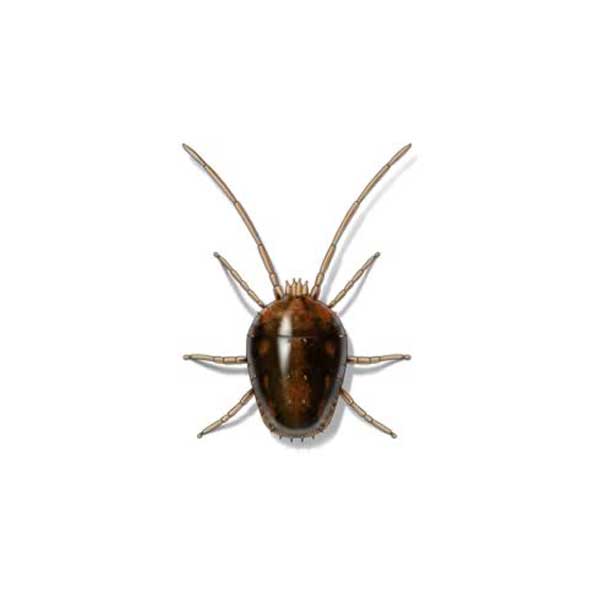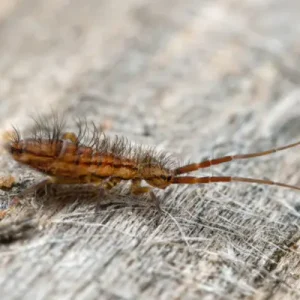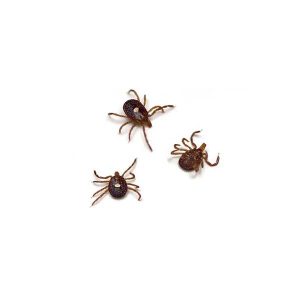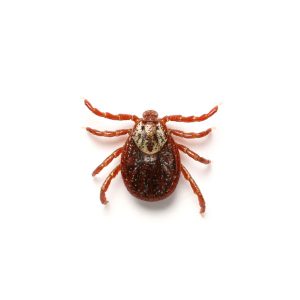What is a Clover Mite?
Clover mites are tiny, reddish-brown pests that can become a nuisance when they invade homes in large numbers. They invade structures by the thousands, mainly in spring and fall. They are often spotted on windowsills, walls, and other exterior surfaces, leaving a characteristic red stain when crushed. Understanding clover mites, where they live, and how to prevent and control an infestation is crucial for maintaining a safe home.
Clover mites, scientifically known as Bryobia praetiosa, are tiny arachnids closely related to ticks and spiders. Clover mites are distributed worldwide and found throughout the United States. Unlike other mites, clover mites do not bite humans or pets but can become a significant nuisance when they invade homes in large numbers. If you’re experiencing an infestation, our residential pest control services are here to help.
Once considered an occasional invader, clover mites are now a serious pest due to the housing boom associated with suburban sprawl and the installation of well-fertilized lawns growing close to the foundations of houses. This proximity to homes allows them easy access indoors, especially during cooler months when they seek warmth and shelter.
What Does a Clover Mite Look Like?
Clover mites are very small, about the size of the head of a pin, making them difficult to see with the naked eye. They are oval-shaped and have a distinctive bright red or reddish-brown color. One of their most notable features is their long front pair of legs, which can be mistaken for antennae. These front legs are much longer than the others and are often used to identify these tiny red bugs.
Habitat
Understanding clover mites’ habitat and life cycle is essential for effective control and prevention. These mites are commonly found in areas with lush vegetation and are known to overwinter in protected areas such as crevices in walls or around windows.
What Attracts Clover Mites?
Clover mites are primarily attracted to heavily fertilized lawns, gardens, and other lush vegetation. They feed on various plants, including grass, clover, and other broadleaf plants. Clover mites prefer the sunny side of houses and buildings, basking in the warmth. During the cooler months, they seek shelter in cracks and crevices of buildings, often leading to indoor infestations. Warm weather in early spring can significantly increase clover mite populations, leading them to invade homes for food and shelter.
Where Do Clover Mites Live?
Clover mites are typically found outdoors, living in grass, shrubs, and other plants. They are especially prevalent in well-manicured lawns with a thick layer of grass. When the weather becomes too hot or cold, clover mites migrate to more protected areas, such as the crevices of exterior walls, under window frames, and around doorways. They can also be found in gardens with ornamental plants like barberry, arborvitae, alyssum, and zinnia. Indoors, they congregate on windowsills, where they are often first noticed.
How Long Do Clover Mites Live?
Clover mites usually live for 2–3 weeks. During this time, they go through different stages: eggs, larvae, nymphs, and adults. They don’t harm people, but they can be annoying when they get into homes, especially in spring and fall.
Proper pest control can help control a clover mite population.
Health Risks and Dangers
While clover mites are not known to pose significant health risks to humans or pets, their presence can still be a cause for concern due to the sheer number of mites that can invade a home. Clover mites are pests not because they bite or cause disease but because they can invade a structure in unbelievable numbers. In 1954, one single bedroom was estimated to have 250,000 mites crawling on the floor! Since clover mites are so small, homeowners may not even recognize them in their houses until they have spread. However, what most people are likely to notice are the red stains clover mites leave behind.
Do Clover Mites Bite Humans?
One common question homeowners ask is, “Do clover mites bite humans?” The answer is no; clover mites do not bite humans. Unlike other mites or insects that feed on blood, clover mites feed on plant material and do not have mouthparts capable of biting or stinging humans. However, their presence can still cause discomfort, as they can enter homes in large numbers and leave red stains on walls, furniture, and other surfaces when crushed.
It’s important not to confuse clover mites with other pests, such as fleas. If you’re wondering, “What do flea bites look like?” they typically appear as small, red, itchy bumps, often in clusters or lines, usually on the lower legs and feet. While clover mites don’t pose the same risks, their sheer numbers can be a nuisance when they invade your living space.
Are Clover Mites Harmful to Pets?
Clover mites are not harmful to pets. They do not bite or transmit diseases to animals. However, they can become a nuisance when they invade indoor spaces where pets live and play. While your pets are unlikely to suffer any direct harm from clover mites, the presence of these pests in large numbers can cause stress and discomfort for you and your pets.
How To Get Rid of Clover Mites
The most effective way to eliminate clover mites and prevent their return is to seek the help of a professional pest control company like Active Pest Control. We have the knowledge, experience, and specialized tools to identify the source of the infestation, implement targeted treatments, and provide long-term solutions to eliminate the problem and prevent future infestations.
Clover Mite Prevention Tips
Here are some effective strategies to keep your home safe from these nuisance pests:
Maintain a Vegetation-Free Buffer Zone
Clover mites are attracted to lush vegetation, so creating a buffer zone around your home can help keep them at bay. Keeping vegetation away from your home’s foundation can reduce the likelihood of clover mites entering your home. Trim grass, shrubs, and other plants back 18 to 24 inches from the foundation. Consider replacing grass or ornamental plants with less attractive options like gravel or mulch, which create a less inviting environment for mites.
Seal Cracks and Crevices
Clover mites often enter homes through small cracks and crevices around windows, doors, and foundation walls. Identify and seal entry points: Regularly inspect your home for potential entry points, such as cracks in the foundation, gaps around windows and doors, and other crevices. Sealing these areas with caulk or weatherstripping will help prevent clover mites from gaining access to your home. Pay special attention to areas where clover mites are commonly found, such as the sunny side of your home.
Reduce Fertilization
Over-fertilized lawns and gardens can attract clover mites, so avoiding excessive fertilization is essential. This can help reduce the attraction of clover mites around your home.
Monitor Mite Populations
Keep an eye on mite populations in your garden and lawn, especially during the early spring when clover mites are most active. If you notice an increase in mite activity, act to reduce their numbers before they can migrate indoors. Vacuum and clean inside your home: Regularly vacuum carpets, furniture, and other surfaces to remove clover mites. Be sure to empty the vacuum bag or canister outside to prevent mites from re-entering your home. Clean surfaces where mites have been found, paying particular attention to windowsills and walls.
Use Plants That Repel Mites
Some plants are less attractive to clover mites and can be used to create a natural barrier around your home. Consider planting species like alyssum and zinnia, which are known to repel mites. This can serve as an additional layer of protection against these pests.
Use Insecticides
Insecticides can effectively control clover mites, mainly when applied to exterior walls, windowsills, and other areas where mites are known to congregate. Look for products labeled explicitly for clover mite control, and follow the manufacturer’s instructions for safe application.
Regular Professional Inspections
If you’re facing a severe clover mite infestation, our experienced flea, tick and mite control experts are here to help. We’ll assess your situation, recommend the most effective treatments, and work to eliminate the problem swiftly. We specialize in residential pest control and offer tailored solutions to meet your needs. Whatever challenges you face, we’re here to assist you.
FAQS
What Can Be Mistaken for Clover Mites?
Clover mites are often mistaken for other small, red pests like spider mites or red velvet mites due to their similar size and color. However, clover mites are unique in their behavior of invading homes in large numbers and leaving a red stain when crushed.
How Do You Tell the Difference Between Clover Mites and Bed Bugs?
Clover mites and bed bugs are quite different in appearance and behavior. Clover mites are tiny, bright red, and have a characteristic long pair of front legs, while bed bugs are reddish-brown, larger, and have a more oval, flattened body. Bed bugs are typically found in bedding and furniture and feed on human blood, whereas clover mites feed on plants and do not bite.
How Can You Tell the Difference Between Clover Mites and Chiggers?
While both clover mites and chiggers are small and red, clover mites are harmless and do not bite, whereas chiggers are parasitic larvae that bite humans and cause itching. Chiggers are usually found in grassy or wooded areas and attach to skin, whereas clover mites are plant feeders often found on walls and windowsills.
Need help with pest control?
Ready for your FREE quote?
Fill out the form below and we’ll be in touch!
*During normal business hours. After hours inquiries will be returned the next business day.





